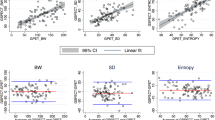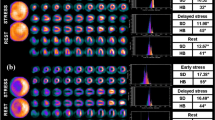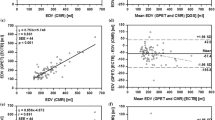Abstract
Purpose
To investigate the value of gated F-18 FDG PET/CT on left ventricular (LV) dyssynchrony assessment in comparison with gated Tc-99m sestamibi SPECT in patients with coronary artery disease (CAD).
Methods
The data of 100 consecutive CAD patients who underwent both gated myocardial Tc-99m sestamibi SPECT and F-18 FDG PET/CT imaging were analyzed. Phase standard deviation (SD) and histogram bandwidth (BW) were derived from phase analysis using Cedars software package. The correlation and agreement of SD and BW between Tc-99m sestamibi SPECT and F-18 FDG PET/CT were examined. Myocardial viability and the site of latest activation assessed by the two imaging methods were compared as well.
Results
A moderate correlation for SD (r = 0.58, p < 0.0001) and BW (r = 0.60, p < 0.0001) was found between gated SPECT and gated F-18 FDG PET/CT. Bland–Altman analysis revealed an overestimation of SD and BW (6.4° ± 14.3° and 22.0° ± 46.8°) by gated F-18 FDG PET/CT. Multivariate logistic regression analysis identified that significant LV remodeling on SPECT imaging, LV functional parameters and F-18 FDG uptake ratio of myocardium to blood pool (SUVM/B) were associated with the overestimation. Myocardial SPECT and F-18 FDG PET/CT had a 67.1 % identity in determining the latest activation site and 5.2 % more viable myocardium was detected by F-18 FDG PET/CT than SPECT.
Conclusion
Gated F-18 FDG PET/CT moderately correlated with gated Tc-99m sestamibi SPECT in assessing LV dyssynchrony. Gated F-18 FDG PET/CT phase analysis should be cautiously applied in CAD patients with significant LV remodeling on SPECT imaging, severe LV functional impairment or poor myocardial F-18 FDG uptake.




Similar content being viewed by others
References
Sanderson JE, Tse TF. Heart failure: a global disease requiring a global response. Heart. 2003;89:585–6.
Fox KF, Cowie MR, Wood DA, Coats AJ, Gibbs JS, Underwood SR, et al. Coronary artery disease as the cause of incident heart failure in the population. Eur Heart J. 2001;22:228–36.
Cha YM, Rea RF, Wang M, Shen WK, Asirvatham SJ, Friedman PA, et al. Response to cardiac resynchronization therapy predicts survival in heart failure: a single-center experience. J Cardiovasc Electrophysiol. 2007;18:1015–9.
Abraham WT, Fisher WG, Smith AL, Delurgio DB, Leon AR, Loh E, et al. Cardiac resynchronization in chronic heart failure. N Engl J Med. 2002;346:1845–53.
Bax JJ, Abraham T, Barold SS, Breithardt OA, Fung JW, Garrigue S, et al. Cardiac resynchronization therapy: part 1—issues before device implantation. J Am Coll Cardiol. 2005;46:2153–67.
Singh JP, Heist EK, Ruskin JN, Harthorne JW. “Dialing-in” cardiac resynchronization therapy: overcoming constraints of the coronary venous anatomy. J Interv Card Electrophysiol. 2006;17:51–8.
Ypenburg C, Schalij MJ, Bleeker GB, Steendijk P, Boersma E, Dibbets-Schneider P, et al. Impact of viability and scar tissue on response to cardiac resynchronization therapy in ischaemic heart failure patients. Eur Heart J. 2007;28:33–41.
Bax JJ, Bleeker GB, Marwick TH, Molhoek SG, Boersma E, Steendijk P, et al. Left ventricular dyssynchrony predicts response and prognosis after cardiac resynchronization therapy. J Am Coll Cardiol. 2004;44:1834–40.
Chen J, Garcia EV, Folks RD, Cooke CD, Faber TL, Tauxe EL, et al. Onset of left ventricular mechanical contraction as determined by phase analysis of ECG-gated myocardial perfusion SPECT imaging: development of a diagnostic tool for assessment of cardiac mechanical dyssynchrony. J Nucl Cardiol. 2005;12:687–95.
Trimble MA, Borges-Neto S, Honeycutt EF, Shaw LK, Pagnanelli R, Chen J, et al. Evaluation of mechanical dyssynchrony and myocardial perfusion using phase analysis of gated SPECT imaging in patients with left ventricular dysfunction. J Nucl Cardiol. 2008;15:663–70.
Chen J, Boogers MJ, Bax JJ, Soman P, Garcia EV. The use of nuclear imaging for cardiac resynchronization therapy. Curr Cardiol Rep. 2010;12:185–91.
Chen J, Garcia EV, Bax JJ, Iskandrian AE, Borges-Neto S, Soman P. SPECT myocardial perfusion imaging for the assessment of left ventricular mechanical dyssynchrony. J Nucl Cardiol. 2011;18:685–94.
Gaemperli O, Kaufmann PA. PET and PET/CT in cardiovascular disease. Ann N Y Acad Sci. 2011;1228:109–36.
Cooke CD, Esteves FP, Chen J, Garcia EV. Left ventricular mechanical synchrony from stress and rest 82Rb PET myocardial perfusion ECG-gated studies: differentiating normal from LBBB patients. J Nucl Cardiol. 2011;18:1076–85.
Pazhenkottil AP, Buechel RR, Nkoulou R, Ghadri JR, Herzog BA, Husmann L, et al. Left ventricular dyssynchrony assessment by phase analysis from gated PET-FDG scans. J Nucl Cardiol. 2011;18:920–5.
Morton KA, Alazraki NP, Taylor AT, Datz FL. SPECT thallium-201 scintigraphy for the detection of left-ventricular aneurysm. J Nucl Med. 1987;28:168–72.
Yang MF, Dou KF, Jiang XJ, He ZX. Tc-99m sestamibi/F-18 FDG myocardial SPECT in Takayasu arteritis with coronary artery involvement. Clin Nucl Med. 2007;32:685–9.
Dilsizian V, Bacharach SL, Beanlands RS, Bergmann SR, Delbeke D, Gropler RJ, et al. PET myocardial perfusion and metabolism clinical imaging. J Nucl Cardiol. 2009;16:651.
Trimble MA, Velazquez EJ, Adams GL, Honeycutt EF, Pagnanelli RA, Barnhart HX, et al. Repeatability and reproducibility of phase analysis of gated single-photon emission computed tomography myocardial perfusion imaging used to quantify cardiac dyssynchrony. Nucl Med Commun. 2008;29:374–81.
Henneman MM, Chen J, Dibbets-Schneider P, Stokkel MP, Bleeker GB, Ypenburg C, et al. Can LV dyssynchrony as assessed with phase analysis on gated myocardial perfusion SPECT predict response to CRT? J Nucl Med. 2007;48:1104–11.
Khandaker MH, Miller TD, Chareonthaitawee P, Askew JW, Hodge DO, Gibbons RJ. Stress single photon emission computed tomography for detection of coronary artery disease and risk stratification of asymptomatic patients at moderate risk. J Nucl Cardiol. 2009;16:516–23.
Bland JM, Altman DG. A note on the use of the intraclass correlation coefficient in the evaluation of agreement between two methods of measurement. Comput Biol Med. 1990;20:337–40.
Bland JM, Altman DG. Statistical methods for assessing agreement between two methods of clinical measurement. Lancet. 1986;1:307–10.
Li D, Zhou Y, Feng J, Yuan D, Cao K, Garcia EV, et al. Impact of image reconstruction on phase analysis of ECG-gated myocardial perfusion SPECT studies. Nucl Med Commun. 2009;30:700–5.
Conflict of interest
The authors indicated they have no financial conflicts of interest.
Author information
Authors and Affiliations
Corresponding authors
Rights and permissions
About this article
Cite this article
Wang, L., Wei, HX., Yang, MF. et al. Phase analysis by gated F-18 FDG PET/CT for left ventricular dyssynchrony assessment: a comparison with gated Tc-99m sestamibi SPECT. Ann Nucl Med 27, 325–334 (2013). https://doi.org/10.1007/s12149-013-0691-y
Received:
Accepted:
Published:
Issue Date:
DOI: https://doi.org/10.1007/s12149-013-0691-y




